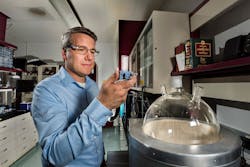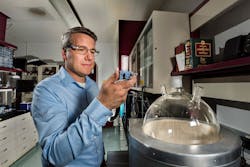Uniform Iron Nanoparticles Key to Potential Cancer Breakthrough
Sandia National Laboratories materials chemist Dale Huber has been working on the challenge of making iron-based nanoparticles the exact same size for 15 years. The goals is to coat small iron particles with cancer antibodies so that when the coated particles are injected into patients, the antibodies and iron will stick to the cancer cells. Medical technicians can then use small magnetic pulses to detect the tagged cancer cells and target them with anti-cancer agents.
For the detection method to work, however, all of the nanoparticles have to be almost exactly the same size; they cannot vey in size by more than 2%.
“A two percent variation is the difference between perfect and just about useless,” says Huber. He adds, laughing, “It was eye opening for me and if had I known how long it would take, I might not have taken on the challenge.”
Until now, the standard method for making iron nanoparticles was to combine the iron-rich ingredients and heat the mixture to about 650° F. How quickly the heat increased determined the nanoparticle size. However, just like your oven at home, the heating apparatus will overshoot the critical temperature and then cool down until it levels off. How much the temperature overshoots this critical temperature also affects the size, producing nanoparticles more than 15% larger or smaller.
Instead, over the years Huber and his team developed a method in which ingredients were slowly added to a molten metal bath whose temperature varies less than half a degree. This creates those nanoparticles with less than 2% size variation.
Sandia National Laboratories materials chemist Dale Huber has worked to make nanoparticles the exact same size for 15 years. His long-term collaborators at Imagion Biosystems will use these magnetic nanoparticles for their first breast cancer clinical trial later this year. He is holding a microfluidic chip that can make tiny amounts of nanoparticles. The round-bottom flask beside him can be used for making much larger quantities of nanoparticles. (Photo by Randy Montoya)
Over the time Huber has been trying to make these uniform nanoparticles, technology was developed that simplified the task,
Small angle X-ray scattering, for example, gave the team a way to determine the size and size distribution of nanoscale materials in 15 minutes. “Seven or eight years ago it would take a week to figure out the same thing using electron microscopy,” says Huber. This almost real-time size measurement let researchers predict how production reactions would end and validate they were on the right path, she said.
The team of national lab scientists and private industry researchers also managed to have two other labs replicate their nanoparticle production approach, which was not a trivial task. One of these labs is in the Netherlands, a country with most of its land near sea level so material characteristcs change such as boiling points.
The next step will be preclinical trials to ensure the tiny iron particles are not toxic, and then creating a small production lot of particles, about half of a teaspoon, for clinical trials. Fortunately, because the nanoparticles are uniform and have excellent magnetic properties, nogt much is needed. The team expects patients will be injected with at most one milligram of particles.
All patients for the first clinical trial will be selected because their oncologists’ treatment regimen includes lymph node removal and biopsy. Before each patient has lymph nodes removed surgically, the magnetic nanoparticles, coated in breast cancer-specific antibodies, will be injected at the site of known tumors. After the removal of nodes, but before the biopsy, the detection device developed by Imagion Biosystem, will examine removed lymph nodes to look for the spread of cancer.
The goal is to ensure the Biosystem device, Magsense, method will be as accurate as pathologists, with the eventual goal of using the nanoparticles first to look for cancer and eliminate the need to remove cancer-free lymph nodes.


